Tag Archive: Driving safety

Proof: Red Light Cameras Aren’t Only About Money
July 29, 2016
There has been a spirited debate over the past few years over whether or not red light cameras save lives or are just a way for cities to make more money. While safety advocates feel that red light cameras are instrumental in saving lives, many, including law makers at both the local and state level, have taken the opinion that the cameras only purpose is to generate income for cities and, in fact, cause more crashes than they prevent. Now, a study by the Insurance Institute for Highway Safety (IIHS) shows that the cameras save lives and shutting them down will cost lives.
The IIHS study is a follow-up to another study that they conducted in 2011 that showed red light cameras not only reduced red light running fatal crashes but other types of fatal crashes as well. The new study was conducted over a longer period of time and looked at a larger number of cities for comparison.
For comparison purposes, the study looked at 57 cities with populations of over 200,000 that activated cameras and kept them in service between 1992 and 2014. Crash data in those cities were compared to the trends in 33 cities that never had cameras installed. The data showed that there were “21 percent fewer fatal red-light-running crashes per capita in cities with cameras than would have occurred without cameras and 14 percent fewer fatal crashes of all types at signalized intersections.” According to the IIHS, an estimated 1,296 lives were saved while the cameras were in operation.
The second part of the study looked at 14 cities that shut off their cameras between 2010 and 2014. The crash data in those cities were compared to the crash rate of 29 nearby cities that have cameras installed. The data showed that the fatal red light running crash rate was 30 percent higher in the cities that had turned off the cameras compared to similar cities with cameras that are still in operation.
Red light cameras have been controversial because they were initially sold to cities as a revenue generator. The money generated from tickets was supposed to more than pay for the camera’s operating costs. However, once drivers realized that there were cameras at certain intersections, they became more careful and stopped running red lights. As a result, ticket revenues went way down and the camera system became too expense to continue in operation. Many cities abandoned their cameras within a couple of years of activating them.
What many don’t realize is that preventing crashes, injuries, and deaths also saves money:
- Productivity is increased when the traffic flow isn’t blocked by a crash.
- Police, fire, and rescue are freed up for other duties and emergencies.
- Insurance costs go down.
Governments should realize that the use of red light cameras is about saving lives and not about generating income. Cities and red light camera manufacturers should work together to come up with viable business plans that rely less on ticket revenue and more on the idea that the cameras save money along with lives.
For more information, visit: Turning off red light cameras costs lives, new research shows
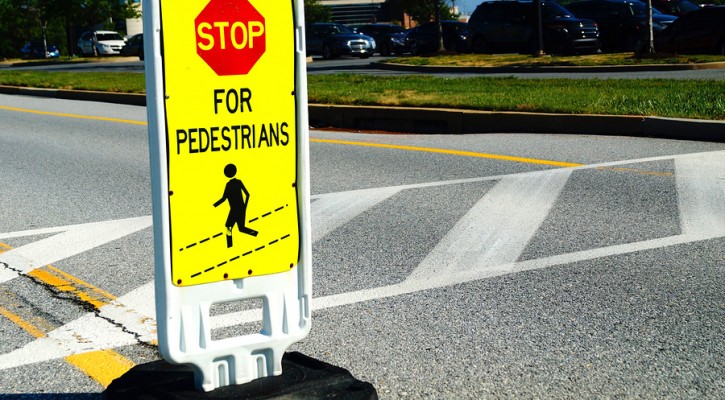
Pedestrian Deaths On The Rise
March 29, 2016
Pedestrian deaths are on the rise according to a new study conducted by the Governors Highway Safety Association (GHSA) and predicts that 2015 pedestrian deaths will increase by ten percent over the previous year.
Data collection by safety organizations takes time and final fatality reports are normally 18 to 24 months behind. To conduct this study, the GHSA asked states for their preliminary data for the first six months of 2015 and compared those numbers to the first six months of 2014. According to the numbers, pedestrian deaths increased in 26 states and the District of Columbia. The rates were unchanged in three states and were down in 21 states.
The data shows that four states; California, Florida, Texas and New York, account for 42 percent of pedestrian deaths even though those states only make up 33 percent of the US population. Florida had the highest rate of pedestrian deaths but surprisingly, the number of pedestrian deaths in Florida declined by four percent over the previous year. Vermont had the lowest rate with zero pedestrian deaths.
While drivers necessarily deserve a lot of blame for pedestrian deaths, the pedestrians themselves must also share in the blame. Distractions for both drivers and pedestrians are on the increase with everyone feeling the need to stay connected online via texting or social media. The issue of texting while walking has become such a problem that the state of New Jersey and some US cities are considering laws to ban texting while walking. In England, a 20 foot statue spanning a walkway at the Salisbury Cathedral in Wiltshire had to be moved because pedestrians, with their eyes downcast looking at smartphones, kept bumping into it even though there was plenty of clearance to pass underneath.
A major problem for both drivers and pedestrians continues to be alcohol which was involved in approximately half of the pedestrian deaths. About 34 percent of pedestrians killed in crashes had a BAC of .08 or higher. Fifteen percent of drivers had a BAC of .08 or higher.
The time of day and place also played a part with 72 percent of pedestrian deaths happening during the hours of darkness. Most pedestrian deaths (74%) occur away from intersections.
According the the GHSA report, pedestrian deaths have been increasing steadily over the past ten years. (Click on the image to enlarge.)
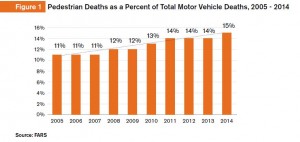
For more information, read: Pedestrian Traffic Fatalities By State – 2015

Florida Receives Failing Grade On Highway Safety Laws
February 17, 2016
An organization called Advocates for Highway Safety (Advocates) says that many state governors and legislatures are failing to do their duty and people are dying needlessly as a result. In a report called the 2016 Roadmap of State Highway Safety Laws, the Advocates call out those states that have failed to pass needed highway safety laws and assigned a grade to each state based on the safety laws passed to date. Florida is one of nine states that received a failing grade on this report.
The report states that, nationwide, there are more than 300 optimal laws which, if enacted, could make highways safer and save lives. According to the Advocates, in 2015, only six states managed to pass a total of eight of those optimal traffic safety laws. Those states were; Kentucky, Mississippi, Oklahoma, Texas, Utah and West Virginia. The Advocates are calling on the rest of the states to make 2016 the year that those necessary traffic laws will be passed into law.
The laws that the Advocates are urging the states to pass include:
Occupant Protection
- Primary Enforcement Front Seat Belt Law -Allows law enforcement officers to stop and ticket the driver for a violation of the seat belt law for front seat occupants without having to first witness another “primary” violation.
- Primary Enforcement Rear Seat Belt Law
- All-Rider Motorcycle Helmet Law – Requires all motorcycle riders, regardless of age, to use a helmet that meets U.S. DOT standards or face a fine.
Child Passenger Safety
- Booster Seat Law – Requires, at a minimum, that children aged four through seven be placed in a child restraint system (booster seat).
Teen Driving
Graduated Driver License (GDL) laws are designed to allow teens more time to learn driving skills without distractions.
- Learner’s Stage: Minimum Age 16 for Learner’s Permit
- Learner’s Stage: Six-Month Holding Period Provision – A beginning teen driver must be supervised by an adult licensed driver at all times during the learner’s stage. If the learner remains citation-free for six months, he or she may progress to the intermediate stage.
- Learner’s Stage: 30 50 Hours of Supervised Driving Provision with an adult licensed driver during the learner’s stage.
- Intermediate Stage: Nighttime Driving Restriction Provision – Unsupervised driving should be prohibited from at least 10 p.m. to 5 a.m.
- Intermediate Stage: Passenger Restriction Provision – This provision limits the number of teenage passengers who may legally ride with a teen driver without adult supervision. The optimal limit is no more than one non-family teenage passenger.
- Cell Phone Restriction – This restriction prohibits all use of cellular devices (hand-held, hands-free and text messaging) by beginning teen drivers, except in the case of an emergency.
- Age 18 for Unrestricted License – A teen driver is prohibited from obtaining an unrestricted license until the age of 18, and one or both of the nighttime and passenger restrictions must last until age 18.
Impaired Driving
- Ignition Interlock Devices (IIDs) – This law mandates the installation of IIDs on the vehicles of all convicted drunk driving offenders, including first time offenders.
- Child Endangerment – This law either creates a separate offense or enhances an existing penalty for an impaired driving offender who endangers a minor.
- Open Container – This law prohibits open containers of alcohol in the passenger area of a motor vehicle.
Distracted Driving
- All-Driver Text Messaging Restriction – This law prohibits all drivers from sending, receiving, or reading a text message from any handheld or electronic data communication device, except in the case of an emergency.
Requirements for passing grade |
Florida’s current law |
|
Primary Enforcement Rear Seat Belt Law |
Individuals over the age of 18 are not required to wear a seat belt in the rear seat. |
|
All-Rider Motorcycle Helmet Law |
Over age 21 with a minimum $10,000 medical insurance policy not required to wear a helmet. |
|
Child Passenger Safety Booster Seat Law |
Booster seats are only required through age 5. No height requirement listed. |
|
GDL programs consist of a learner’s stage, then an intermediate stage, before being granted an unrestricted license. |
Florida does not have an Intermediate Stage license. |
|
Minimum Age 16 for Learner’s Permit |
Minimum age in Florida is 15. |
|
Nighttime Driving Restriction Provision – Unsupervised driving should be prohibited from at least 10 p.m. to 5 a.m. until age 18. |
Licensed Driver Age 16 – Must not drive between 11 pm to 6 am Licensed Driver Age 17 – Must not drive between 1 am to 5 am |
|
GDL – Intermediate Stage: Passenger Restriction Provision |
There are no limits on the number of teen passengers a teen driver may carry. |
|
GDL – Cell Phone Restriction |
There are no cell phone restrictions for teen drivers. |
|
Ignition Interlock Devices (IIDs) – Mandates the installation of IIDs on the vehicles of all convicted drunk driving offenders. |
Ignition Interlock Devices (IIDs) may be court ordered for a first offense but they are not mandatory. |
|
All-Driver Text Messaging Restriction |
Florida’s texting law is a secondary offense and is basically unenforceable. |
To express your views on these important highway safety laws, find out how to contact your state representatives by visiting: Find your state legislator
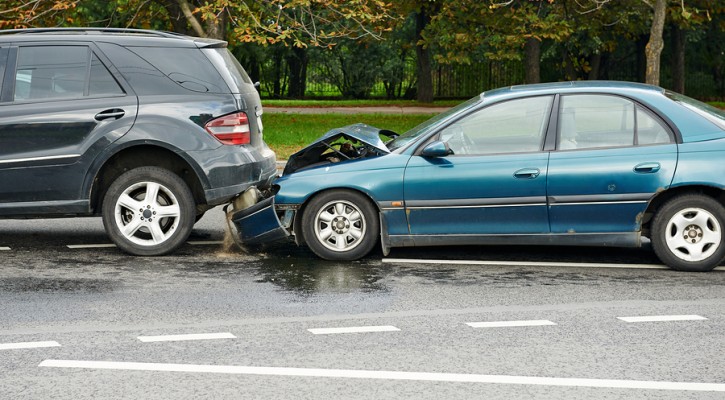
Front Crash Prevention Systems Reduce Car Crashes
February 4, 2016
Vehicles equipped with front crash prevention systems are less likely to rear end other vehicles according to the first study of its kind conducted by the Insurance Institute for Highway Safety (IIHS).
While front crash prevention systems, also known as automatic braking or collision avoidance systems have been around for a few years, they’ve primarily been available only as an option on higher end model cars. There hadn’t been enough of them in use to show any trends until recently when IIHS researchers used data from police reported front end crashes to compare the same model vehicles equipped with front crash prevention systems and those without.
According to the data, front crash prevention systems that included automatic braking reduced the number of rear end collisions by about 40 percent. Those vehicles with collision avoidance warning alone reduced the number of crashes by about 23 percent. The number of crashes resulting in injury to vehicle occupants was also greatly reduced.
The study’s authors said that if all vehicles were equipped with automatic braking systems, there would have been 700,000 fewer rear end crashes in the US in 2013. Overall, that number represents approximately 13 percent of all police reported crashes.
Those vehicles with automatic braking reduce the number and severity of crashes by:
- Automatically applying the brakes in time to avoid the crash completely, or
- Slowing the car enough to lessen the degree of damage or injuries.
A survey last year showed that American consumers would rather have collision avoidance systems than wireless technology in their new cars and the National Transportation Safety Board (NTSB) put out a transportation system wish list that included front crash prevention systems as standard rather than optional equipment in new vehicles.
This past October, ten vehicle manufacturers announced that they would soon start including front crash prevention and automatic braking systems as standard equipment on all new vehicles sold in the US. Once that starts to happen, we can expect to see a significant decline in motor vehicle crashes as the newly equipped vehicles hit the road. Until then, we’ll still have to depend on our incredibly slow brains to pay attention to the road ahead and avoid distractions.
Read more: Crashes avoided – Front crash prevention slashes police-reported rear-end crashes
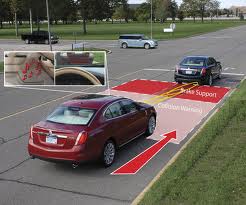
Automatic Emergency Braking To Become Standard On Most Vehicles
October 5, 2015
Ten automobile manufacturers have committed to making automatic emergency braking (AEB) standard equipment in all cars manufactured for the US and Canadian market according to a joint announcement by the National Highway Traffic Safety Administration (NHTSA), the US Department of Transportation (DOT), and the Insurance Institute for Highway Safety (IIHS).
Automatic emergency braking uses sensors such as lasers, cameras, radar, or sonar to detect an imminent crash. The system gives the driver a warning and, if the driver doesn’t take action in time, the system will automatically apply braking to avoid the crash. An IIHS study reported that the technology could reduce insurance injury claims by as much as 35 percent.
The system has been offered by several manufacturers over the past several years but only as an option on their high end models. The ten manufacturers who agreed to make the system standard equipment on all models are; Audi, BMW, Ford, General Motors, Mazda, Mercedes-Benz, Tesla, Toyota, Volkswagen and Volvo. Those manufacturers represent 57 percent of the light duty model vehicles produced in the US each year. The automakers have agreed to work with NHTSA and IIHS over the next few months to agree on the details and a start date for implementation of the program.
The act of voluntarily agreeing to make new safety technology standard equipment is unprecedented in the auto industry. Normally, NHTSA suggests standardization of a system and, with the automakers kicking and screaming the whole way, congress then has to pass a law making it required equipment. Two things are happening to change the way things are done between the federal government and the auto industry.
In 2013, IIHS added automatic braking systems to the requirements for a vehicle to earn the designation as a “Top Safety Pick +” in its annual list of safest cars. In January of this year, NHTSA announced that it was adding automatic emergency braking to its “wish list” of required safety equipment on new cars.
By voluntarily agreeing to add automatic emergency braking to their list of standard equipment, the automakers avoid the hassles of dealing with government regulators and remain in charge of the process. Also, as more and more buyers look at the IIHS safety ratings as part of the decision process when selecting a new car, adding automatic emergency braking will also help them get the highly coveted “Top Safety +” designation.

Speed Cameras And Driver Behavior
September 29, 2015
We have often spoken about driver behavior as the issue behind the dangerous conditions on America’s roads. While many want to blame bad roads, restrictive laws, and “other” drivers, the problems on our roads all boils down to individual driver behavior. Even the worst of roads can be driven safely if drivers adjust their behavior to adapt to road conditions and, while we can’t always do anything about the other driver’s behavior, the way we adjust our driving behavior can help protect us from those other drivers.
The problem in adjusting driver behavior is that many drivers, who are in fact dangerous drivers, see their driving behavior as good and everyone else as dangerous. For example, many drivers don’t see speeding as a big problem because they feel they have complete control of their vehicle and can handle any situation. What they fail to see is that speeding reduces the time they have to react to an emergency situation and increases the crash forces. Speeding is directly responsible for approximately one-third of all the traffic fatalities in the US every year.
In that kind of situation, the only thing that can change a driver’s behavior is some sort of outside influence that forces them to adjust. A recent study by the Insurance Institute for Highway Safety (IIHS) found one place where that has happened.
In 2007, Montgomery County, MD installed speed cameras on residential roads with speed limits of 35 mph or less and in school zones. The program has grown over the years to include 56 fixed cameras, 30 portable cameras and 6 mobile speed vans.
Six months into the program, the number of drivers exceeding the speed limit by more than 10 mph had fallen on roads where the cameras were located. After seven years, the study shows that the cameras have reduced the incidence of drivers traveling over the speed limit by more than 10 mph by 59 percent.
When compared with similar roads in nearby Virginia counties, the researchers found a 19 percent reduction in the likelihood that a crash would involve a fatality or an incapacitating injury, as reported by a police officer on the scene.
Montgomery County expanded the program to include speed camera corridors where the focus was moved from a single portion of a roadway to long corridors. The cameras are regularly moved to different locations along the corridor so that drivers don’t become familiar with their exact location. As a result, the speed camera corridors have reduced the chances of a crash involving fatal or incapacitating injury an additional 30 percent beyond the use of cameras alone.
In other words, speed cameras have forced a positive change in driver behavior in Montgomery County and the roads are much safer as a result. According to the IIHS, “If all U.S. communities had speed-camera programs like the one IIHS studied in Maryland’s Montgomery County, more than 21,000 fatal or incapacitating injuries would have been prevented in 2013.
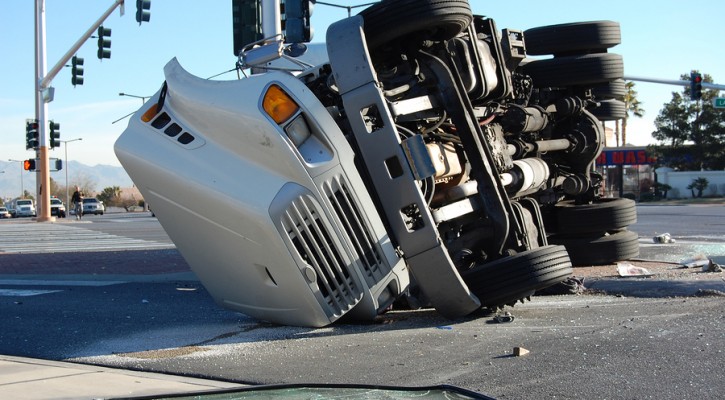
Dangerous Changes For Trucking Industry Still Under Consideration By Congress
August 13, 2015
On July 30, the senate passed a transportation bill that included major changes for the trucking industry that many highway safety advocates say pose a danger to the traveling public. Before the bill could be approved by the house, the house had already left for their summer recess. That means that the proposed changes for the trucking industry will still be on the table when the bill is considered before a three-month stopgap funding bill expires at the end of October.
The transportation bill’s changes to trucking industry regulations that highway safety advocates consider to be dangerous include:
- A provision that would force the Federal Motor Carrier Safety Administration (FMCSA) to hide the safety ratings of trucking companies from the public. If passed, this provision would prevent shippers from accessing and considering the safety ratings of a trucking company they might wish to hire. According to the National Highway Transportation Safety Administration (NHTSA), large-truck drivers in 2013 had the highest percentage (15%) of previously recorded crashes compared to drivers of other vehicle types.
- A provision that would lower the legal age limit to hold a commercial driver’s license for interstate truck drivers from 21 to 18. According to National Highway Transportation Safety Administration (NHTSA) data, 18-20 year old drivers have a fatal crash rate that is 66 percent higher than that of drivers over the age of 21.
- A provision that would change the maximum length of double trailers from 28 feet to 33 feet and would force states that currently ban longer double trailers within their borders to accept the new federal lengths. Safety advocates fear that the wider turning radius and longer length of these double trailers will lead to more collisions.
These proposed changes come on top of the new rules enacted by congress last January that overturned the driving time limits and rest requirements for truckers that had been put in place by the FMCSA in 2013. The trucker responsible for the crash that disabled comedian Tracy Morgan and killed one of his friends had been awake for 28 hours before the crash.
According to NHTSA, there were 3,906 trucks involved in fatal crashes in 2013. Of the 3,964 people killed in those crashes, 71 percent were occupants of other vehicles. In 2013, there were approximately 95,000 people injured in crashes involving large trucks.
If you agree with the safety advocates that these changes go too far and pose a danger to the traveling public, you can let your congressional representatives know. To find contact information for your congressional representatives, visit: Find Your Senators and Representatives

Bill Would Allow Interstate Trucking Licenses For 18 Year Olds
July 13, 2015
A bill introduced in the US senate last week would lower the age limit for interstate truckers and allow 18 year olds to drive trucks across state lines. Under current federal law, drivers must be at least 21 to obtain a commercial driving license (CDL) to drive semi trucks across state lines. The legislation was introduced by Sen. Deb Fischer, R-Neb, as part of a larger transportation bill, in response to requests by the trucking industry to make up for a shortage of truck drivers nationwide.
This reduction in age limits for truckers comes after congress relaxed rules that were designed to keep sleepy truckers off the road. In 2013, the Federal Motor Carrier Safety Administration, in response to an 18 percent increase in fatal truck crashes over the previous three years, enacted rules designed to require longer rest periods for drivers. The new rules reduced the amount of time truckers could spend on the road from 82 to 70 hours per week and no more than 11 hours of driving within a 14 hour workday. Under a law passed by congress, those rules were reversed in January 2015.
According to National Highway Transportation Safety Administration (NHTSA) data from its Fatality Reporting System (FARS), 18-20 year old drivers have a fatal crash rate that is 66 percent higher than that of drivers over the age of 21.
Some states currently allow 18 year olds to qualify for a CDL license to drive trucks within state borders (intrastate) only but federal law prohibits them from driving across state lines (interstate) until they are 21. According to the trucking industry, it doesn’t make sense to allow intrastate driving by 18 year olds but prohibit them from interstate driving. However, safety advocates feel that 18 year olds don’t have the experience or the wisdom to drive big rigs safely over long distances.
The current laws that limit 18 year old truck drivers to intrastate driving basically come with a built in restriction on the number of hours the trucker can be on the road. There’s only so far you can travel within a state.
Under the proposed law, 18 year old truckers wouldn’t have the ability to drive across all state borders. States would have to enter into compacts with adjoining states to allow 18 year olds to drive across their borders but there is no limit on the number of states that could enter into such compacts. Safety advocates who are against the law fear that, with pressure from the trucking lobby, most states will enter into the compacts regardless of the possible risks.
According to the law, 18 year olds won’t be able to haul hazardous materials or to drive over-size or “specially configured” loads. States can impose additional restrictions on 18 year old drivers if they wish.
What do you think of the proposed law? Does it make sense or should the current rules stay in place? Contact your representative to share your feelings.
Read more: Teen truckers? Bill would lower interstate truck driver age to 18; industry cites shortage
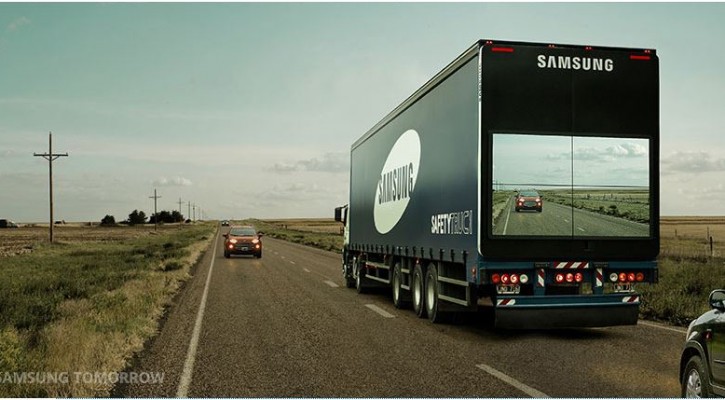
Samsung Tests Safety Technology To Improve the View Ahead
June 22, 2015
Samsung is testing a fairly simple product idea that could make driving safer and save a lot of lives.
If you’ve ever been stuck behind a large semi on a narrow road, you know the frustration that comes from not being able to see the road ahead in order to pass the truck safely. Even when the truck may be going relatively slowly, its size makes passing hazardous because of the extra time required to pass and the danger of unseen oncoming traffic. This frustration can lead drivers to make dangerous choices that can result in a crash.
By using a front mounted camera and four large display screens on the rear of the truck, Samsung is testing a video display that will show the road ahead to drivers behind the truck. The video display of the road ahead works even on the darkest roads. Hopefully, the video display will allow drivers to make more informed and safer choices when deciding whether or not it’s safe to pass.
Noting that it has one of the highest highway death rates in the world and that many of the roads there are two lane roads, Samsung started testing this new idea in the country of Argentina.
According to the Samsung blog, the results look promising but more testing needs to be done.
Part of the data that needs to be evaluated is whether or not drivers will adapt to using this technology for its intended purpose or will it become just another driver distraction that takes the driver’s attention away from the road as a whole. Before testing can be done in other countries, testing protocols have to be developed and government permission has to be obtained.
Unfortunately, while the technology could prove to be extremely helpful to drivers behind a truck, it won’t do anything to eliminate the large no-zones around a truck that prevent the truck driver from seeing vehicles behind and alongside. Drivers will still need to be aware of and respect the no-zones while attempting to pass.
Read more: The Safety Truck Could Revolutionize Road Safety
Photo: Courtesy of Samsung
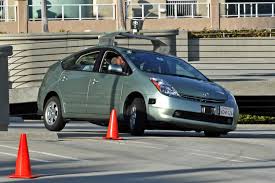
Self Driving Cars Weren’t At Fault In Small Number Of Crashes
May 13, 2015
Self driving cars have recorded very few crashes and, for the most part, weren’t at fault in those they did experience according to research done by the Associated Press.
While self driving cars, have been on the road for several years, the manufacturers weren’t required to publicly report crashes involving their cars until a new California law went into effect in September of 2014. That law made public reporting of crashes involving self driving cars a part of the licensing agreement to test the cars on state roads.
Google has been driving their self driving cars on California roads for six years. At all times, there are engineers behind the wheel ready to take over in case something goes wrong. According to Google, the cars have have driven more than 1.7 million miles with one million of those miles completely automatic.
According to Google, their 23 cars have been involved in eleven minor crashes with only minor damage and no injuries. Google claims that none of the cars on automatic mode were at fault in the crashes.
In April, in the first trip of its kind, Delphi Automotive sent a self driving car across the country from California to New York with 99 percent of the driving done by the car’s automatic controls. There were no reported incidents. Delphi did report one crash previous to the cross-country trip in which the driver of the other vehicle was at fault.
The promise of self driving cars is that they will make driving safer because, unlike human drivers, they follow traffic rules, obey the speed limit, and watch for hazards on the road. Even in an “unavoidable” crash, say with a red light runner, the self driving car can react quicker and apply the brakes or perform an evasive maneuver that will lessen the impact of the crash.
As of now, four states (California,Nevada, Michigan and Florida) plus the District of Columbia have passed laws authorizing testing of self driving cars on their roads. None of the other states outside of California have reported any crashes.
